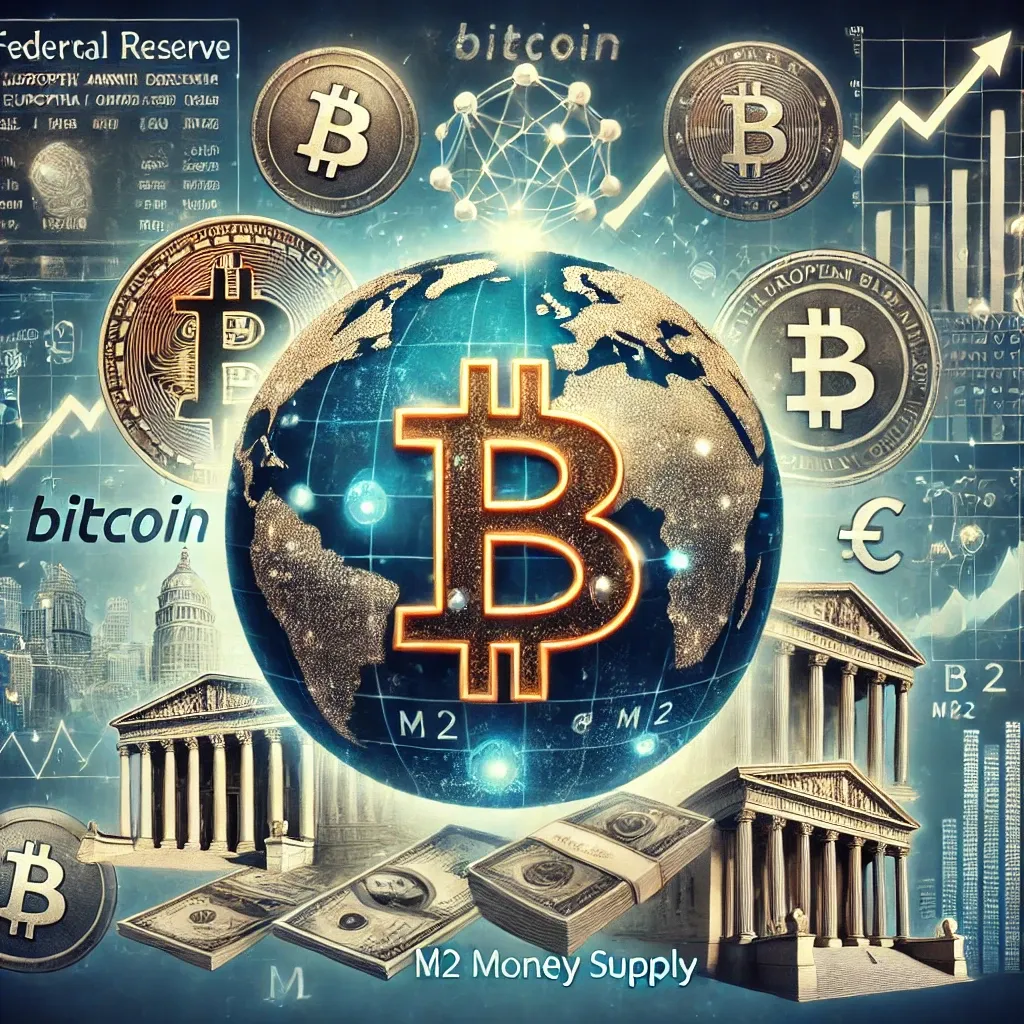: How does Bitcoin’s growth correlate with the global M2 money supply? Explore the impact of monetary policies from the Fed, ECB, and major institutions like JPMorgan and China, and understand how this influences the market.Bitcoin’s remarkable growth over the past decade has generated significant attention across the globe. Its decentralized nature, combined with its potential to serve as an alternative asset, has made it a point of interest for both retail and institutional investors. As Bitcoin gains traction, it is essential to examine how its growth relates to the expansion of the global M2 money supply—a crucial indicator of global financial health and liquidity. This relationship plays a key role in shaping the economic landscape, influencing everything from inflation to market cycles.The global M2 money supply refers to a category of money that includes all physical cash, checking accounts, and easily convertible near money. As central banks, such as the Federal Reserve (Fed) in the United States, the European Central Bank (ECB), and the People’s Bank of China (PBoC), inject more liquidity into the system, the expansion of M2 is often seen as a precursor to inflation and can significantly impact the value of both traditional assets and cryptocurrencies like Bitcoin. Let’s dive deeper into the connections between Bitcoin growth and M2 supply expansion across various financial systems.
Bitcoin and M2 Growth: The Global Outlook
Bitcoin’s price has always been influenced by broader macroeconomic factors, including the expansion of M2 money supply globally. This is particularly evident during times of monetary easing when central banks increase the money supply to stimulate economic growth. By adding liquidity to the system, central banks hope to lower interest rates and encourage spending and investment.However, when the supply of money increases too quickly, it can lead to inflation, eroding the purchasing power of fiat currencies. This is where Bitcoin’s potential as a hedge against inflation comes into play. With its fixed supply of 21 million coins, Bitcoin offers a contrast to the inflationary nature of fiat currencies, making it an attractive investment for those seeking to preserve value in the face of a growing money supply.
Key Influences on Bitcoin and M2 Growth:
- Federal Reserve (US): The Fed’s monetary policies have a major impact on global M2 growth. As the Fed continues to adjust interest rates and engage in quantitative easing, the U.S. dollar’s supply increases, driving both Bitcoin’s appeal as a store of value and potential price surges.
- European Central Bank (ECB): Similarly, the ECB’s policies in Europe contribute to the overall money supply expansion. As the ECB enacts monetary measures to stabilize the eurozone, Bitcoin gains attention as an alternative to traditional currencies.
- People’s Bank of China (PBoC): The PBoC plays a significant role in global liquidity, particularly through its initiatives to control China’s money supply. This has major implications for Bitcoin’s value, especially as China’s regulatory stance on cryptocurrency fluctuates.
- JP Morgan and other major financial institutions: Traditional financial institutions like JPMorgan have also started to embrace Bitcoin, leading to further integration between the digital and traditional financial worlds.
👉 Explore Bitcoin and M2 Growth 👈
Bitcoin’s Price and Market Cycles
One of the defining features of Bitcoin is its volatile market cycle, which is closely linked to the broader economic environment, including M2 growth. Bitcoin has historically gone through phases of rapid price increases followed by corrections. Understanding these cycles requires an awareness of global liquidity and monetary policies.When M2 growth is high, there is often more money circulating in the economy, which increases the demand for assets like Bitcoin. However, when central banks tighten monetary policy and reduce liquidity, Bitcoin prices tend to fall as investors seek safer assets.
How Bitcoin Cycles Relate to M2 Growth:
- Inflation Hedge: During periods of high M2 growth, Bitcoin’s role as an inflation hedge becomes more pronounced, leading to increased demand and rising prices.
- Monetary Tightening: When central banks like the Fed begin tightening, Bitcoin’s price often suffers as liquidity recedes from the market.
- Institutional Adoption: As institutional investors, including large financial players like JP Morgan, enter the market, Bitcoin’s price often experiences upward momentum, driven by the liquidity injected by these institutions.
- Bitcoin Halving Events: Every four years, Bitcoin undergoes a halving, reducing the rate of new Bitcoin creation. This event often leads to supply shocks and can result in price surges, especially during times of high M2 growth.
- Global Uncertainty: Economic uncertainty, such as recessions or geopolitical instability, often leads to increased demand for Bitcoin as a safe haven asset.
👉 Learn More About Bitcoin Market Cycles 👈
Bitcoin and Global Monetary Policy: A Powerful Intersection
The relationship between Bitcoin and M2 growth is most evident when we look at how global monetary policies impact both markets. Central banks’ decisions on interest rates, money supply, and bond buying all affect the broader economic landscape and, by extension, the performance of Bitcoin.The expansion of M2 can be viewed as a reaction to economic conditions that require stimulus—whether it’s a need to combat recession or ensure liquidity during crises. The increase in M2 supply has the unintended side effect of devaluing fiat currencies, while Bitcoin, with its scarcity, becomes more attractive as an alternative investment.
How Central Bank Policies Impact Bitcoin:
- Monetary Easing: When central banks reduce interest rates and increase the money supply, the value of fiat currencies decreases, making Bitcoin an appealing hedge.
- Quantitative Easing (QE): QE policies, implemented by central banks to inject liquidity into the system, often lead to increased interest in Bitcoin as a non-correlated asset.
- Global Coordination: In times of global financial crises, when major banks like the Fed, ECB, and the PBoC work in tandem to stimulate the economy, the compounded effect on Bitcoin can drive its value upward.
- Regulatory Changes: Regulatory stances on cryptocurrency also play a key role. As financial institutions such as JPMorgan adopt Bitcoin, it helps drive its legitimacy and integration into the financial system.
👉 Discover Global Monetary Policy and Bitcoin 👈
Conclusion
The growth of Bitcoin and its relationship with global M2 money supply is an intricate and evolving dynamic that affects both traditional markets and cryptocurrencies. As central banks continue to expand the money supply, Bitcoin’s role as a store of value, an inflation hedge, and an alternative asset becomes increasingly significant. Whether you’re an investor looking to diversify your portfolio or someone interested in the broader implications of monetary policy, understanding this relationship is key to navigating the future of global finance.As the world continues to embrace digital assets, Bitcoin stands at the intersection of economic forces and technological innovation. “The only way to truly understand value is by comparing it to something else,” said Warren Buffett, and in the case of Bitcoin, that something else may just be the world’s evolving monetary policies.






